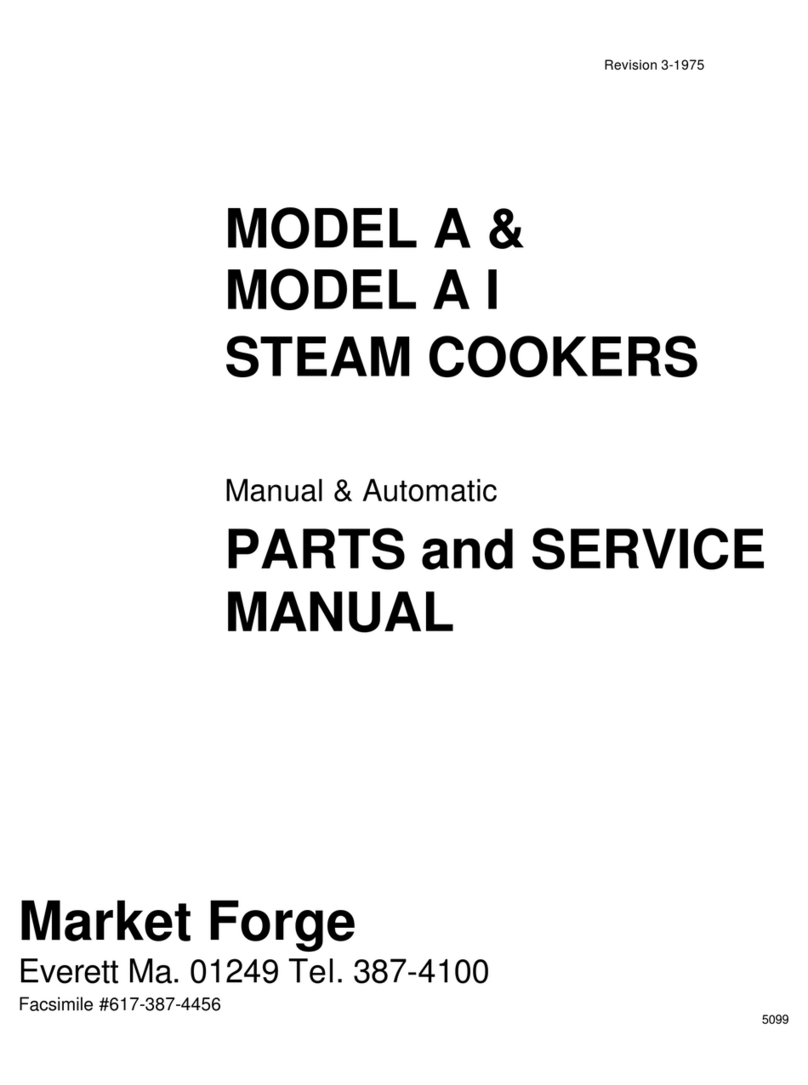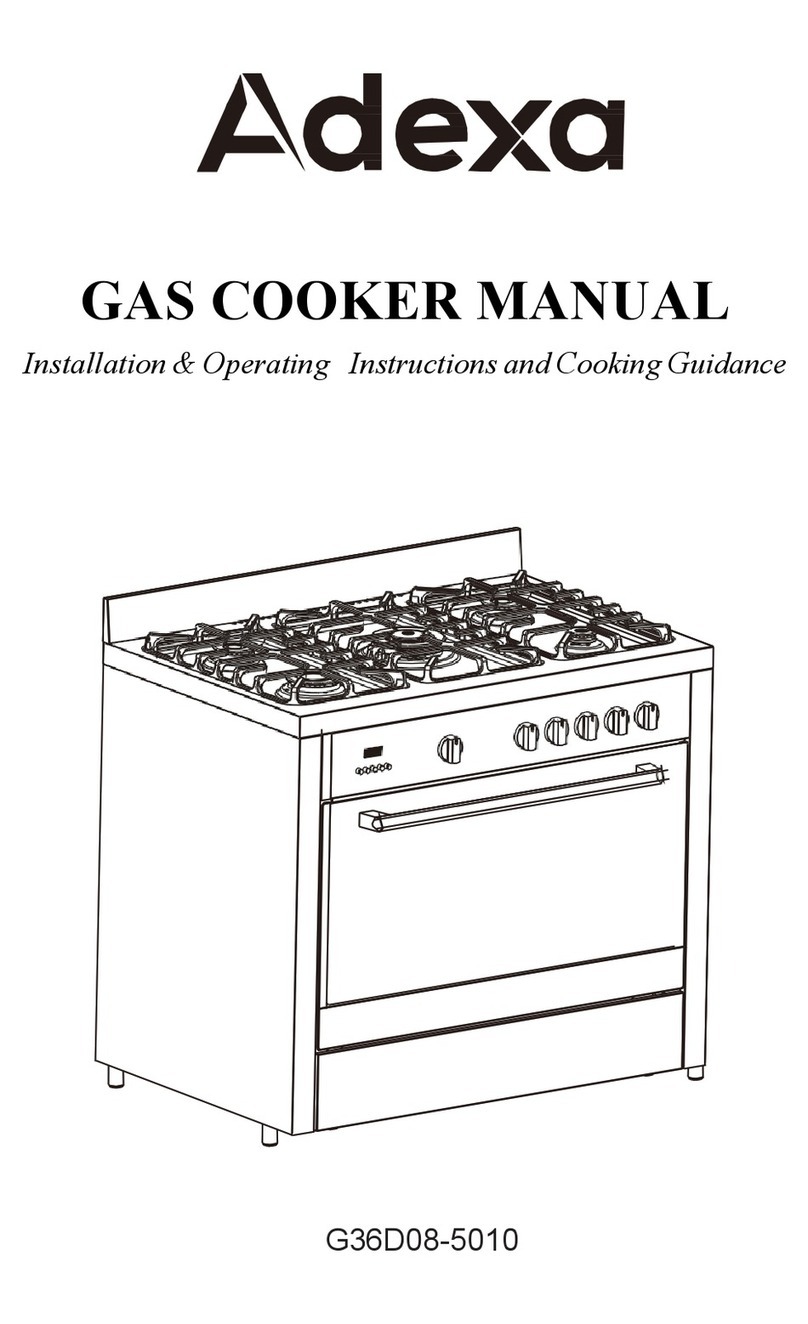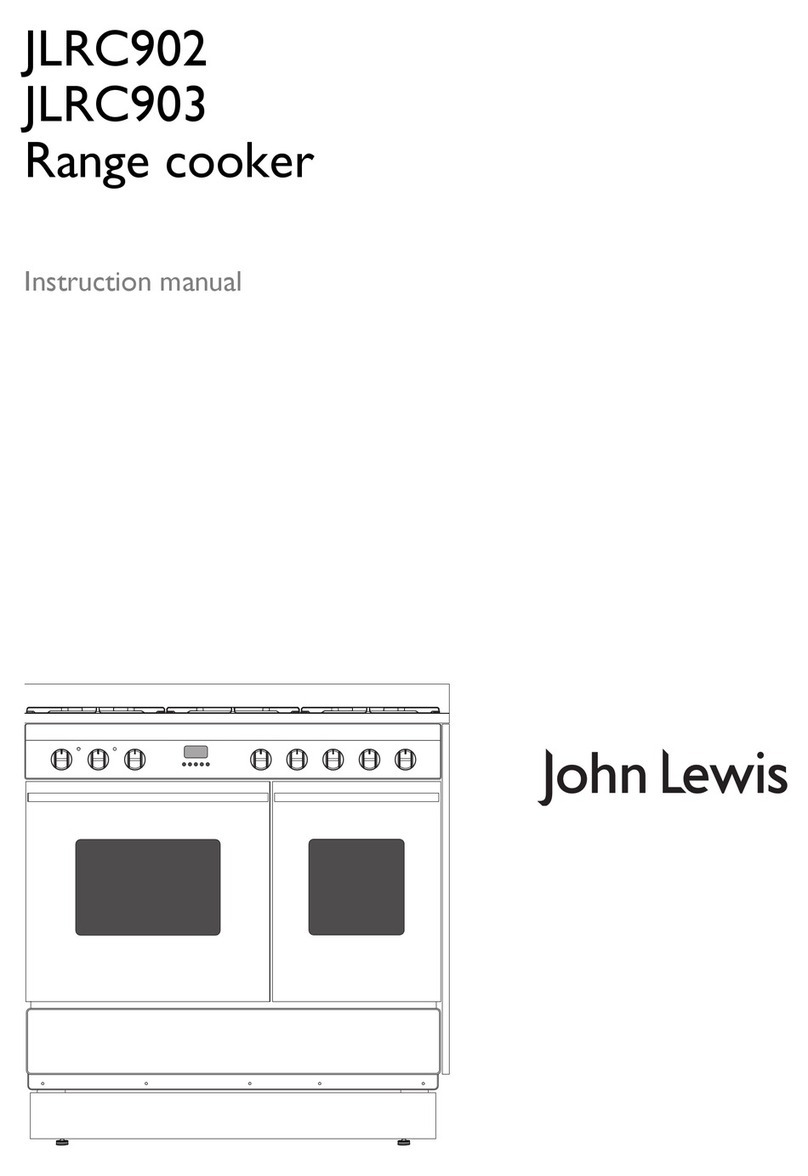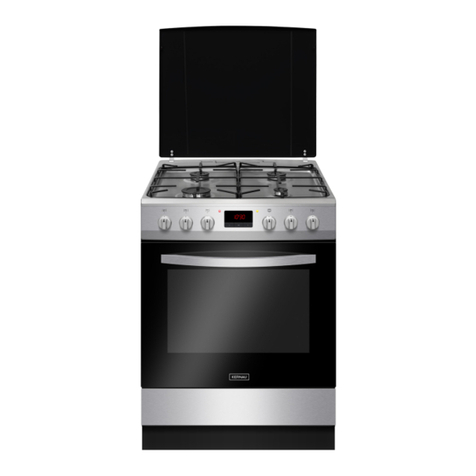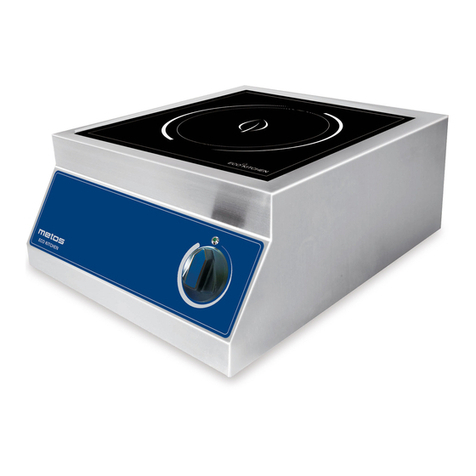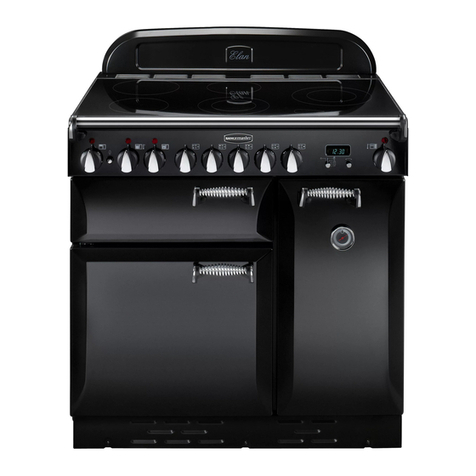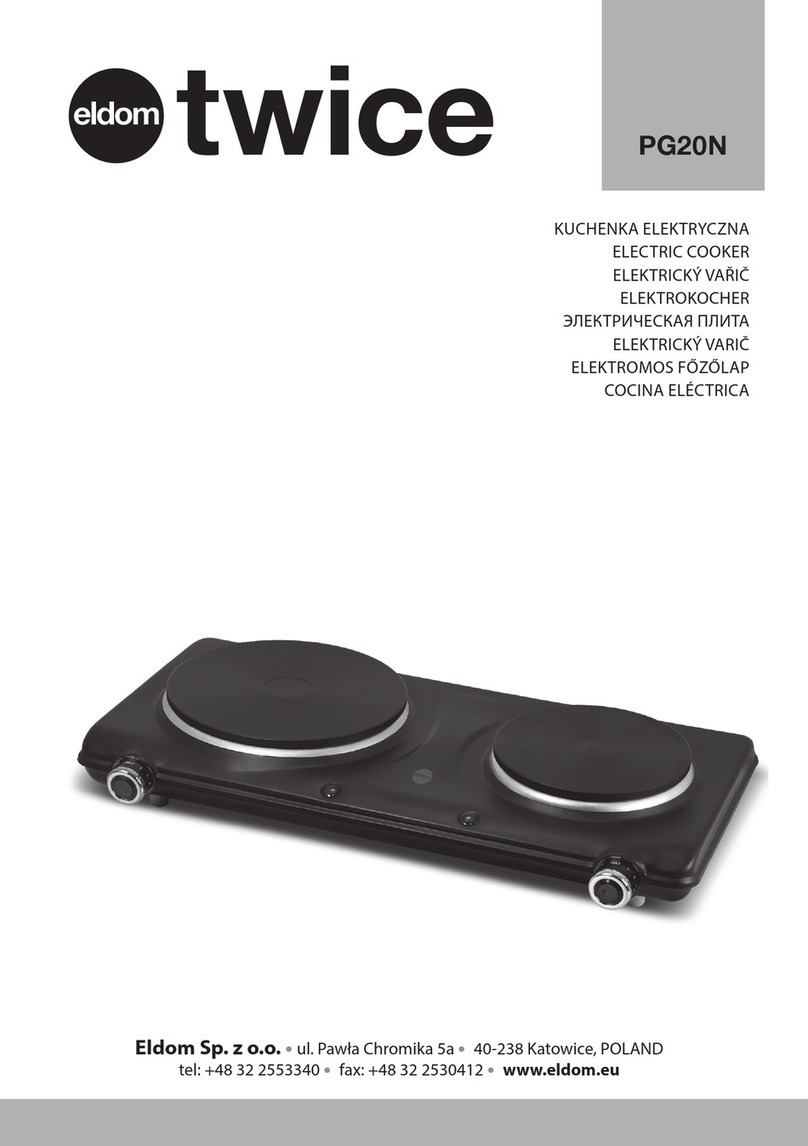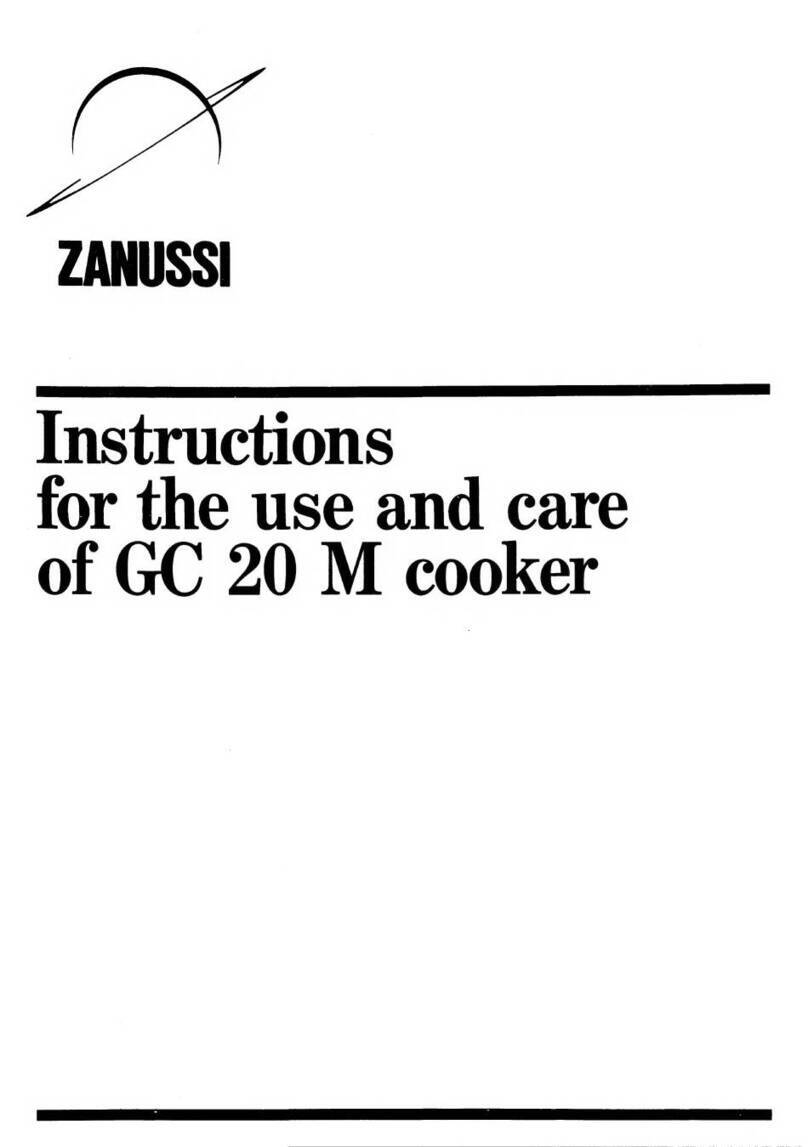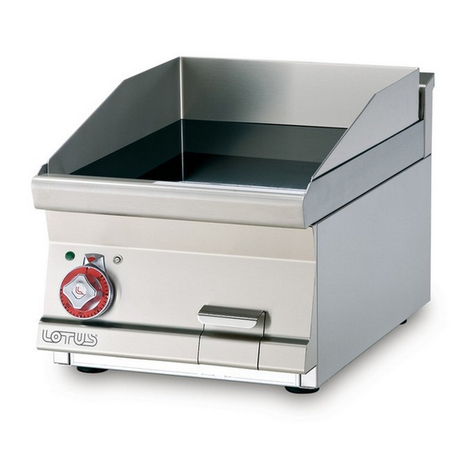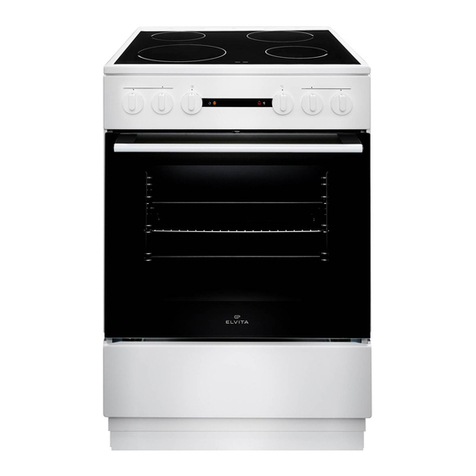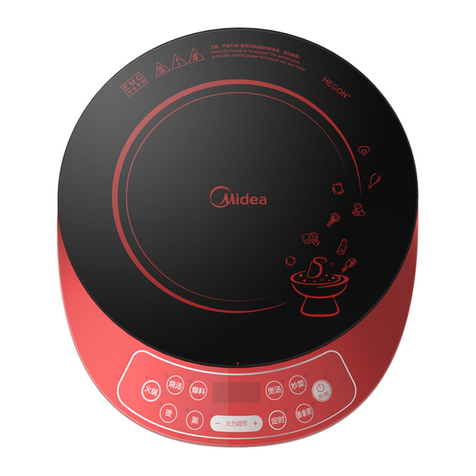Market Forge Industries STEAM-IT ST-AG Guide

SERVICE &
PARTS MANUAL
STEAM·IT, STYLE F
GAS OPERATED COOKER
MODELST·AG
An
Employee Owned Company
Form Number S2127 Printed in U.S.A. Copyright 1977 35 Garvey Street, Everett, MA 02149-4403

TABLE OF CONTENTS
' '.l.;·.1
SECTION 1 INTRODUCTION
1.1 Description .
1.2 Basic Functioning .
1.3 Service.
SECTION 2 INSTALLATION
2.1 Unpacking and Assembly .
2.2 Setting in Place .
2.3 Gas Connection .
2.3.1 Pressure Regulator Setting .
2.3.2 Canadian Gas Connections .
2.4 Electrical Connection .
2.5 Water and Drain Connections .
2.6 Installation Checkout .
2.6.1 Initial Control Setting .
2.6.2 Cooker Checkout .
2.6.3 Shutdown Procedure .
SECTION 3 OPERATION
3.1 Operating Controls and
Indicators .
3.2 Operating Procedures .
3.2.1 Preliminary Procedures .
3.2.2 Preheating .
3.2.3 Cooking Procedures ...
3.2.4 Low Water Cut-Off Operation .
3.2.5 Shut-Down Procedure .
3.3 Cleaning .
3.3.1 Exhaust Silencer .
SECTION 4 PRINCIPLES OF OPERATION
4.1 General .
4.2 Detailed Operation .
4.3 Steam Circuit. . .. . .
4.3.1 Steam Trap .
4.3.2 Pressure Switches .
4.3.3 Steam Pressure Gauge and
Safety Relief Valve .
4.3.4 Steam Exhaust Valve and
Silencer .
4.4 Electrical Circuits .
4.4.1 Control Circuit Components .
1·1
1·1
1.,
2·1
2·1
2·'
2·1
2-1
2·2
2-2
2·2
2-2
2·3
2-3
3-1
3·'
3-1
3·,
3-1
3-3
3-4
3-4
3-4
4-1
4-1
4-1
4·1
4·1
4-1
4-1
4-2
4-2
I .•".
SECTION 5 TROUBLE-SHOOTING
5.1 General. . . . . . 5·1
5.2 Trouble-Shooting Guides. . . . . .. 5·'
5.3 Electrical Fault Isolation. . . 5·1
54 Electrical Trouble-Shooting
Procedures. . . . . . . . . . . . 5·3
5.4.1 Incoming Power. . . . . . . . . . . . . .. 5·3
5.4.2 Electrical Inspection . . . . . . . 5-5
5.4.3 Direct Spark Ignition Control
System . . . . . . . . . . . . . . 5·5
5.4.4 50-Minute Timer. . . . . . . . . . . . . 5-7
54.5 Solenoid Gas Valve. . . . . . . . . 5-7
5.4.6 Buzzer. . . . . . . . . . . . . . . . . . . . . .. 5-7
5.4.7 Indicator Light.. . ... . .. .... . 5-7
5.4.8 Wiring . . . . . . . . . . 5-8
SECTION 5 MAINTENANCE
6.1 General... . . . . . . . .. 6-1
6.2 Preventive Maintenance. . . . . . .. 6-1
62.1 Door Disassembly and Cleaning. 6-1
6.2.2 Safety Valve Check. . . 6-2
62.3 Door Fulcrum and Drain Cleaning
and Lubrication. . . . . . . . . . . . . .. 6-2
6.2.4 Cooki ng Compartment. . . . . . . .. 6-2
6.2.5 General Inspection . . . . . . . . . . .. 6-2
6.3 Repair and Replacement. . . . . . .. 6-3
6.3.1 Door Assembly. . . . . . . . . . . . . . .. 6-3
6.3.2 Exterior Panel Removal. . . . . . . .. 6-4
6.3.3 Steam Exhaust Valve and Trap
Replacement. . . . . . . . . . . . . . . .. 6-4
6.3.4 Direct Spark Ignition System. . .. 6-4
6.4 Adjustments and Operational
Checks. . . . . . . . . . . . . . . . . . . . .. 6-5
6.4.1 Gas Burners and Pressure
Regulator. . . . . . . . . . . . . . . . . . .. 6-5
6.4.2 Electrode Assembly. . . . . . . . . . .. 6-5
6.4.3 Solenoid Gas Valve. . . . . . . . . . .. 6-5
6.4.4 Timer and Gas Control Switches. 6-5
SECTION 7 ILLUSTRATED PARTS LIST
7.1 General...................... 7-1
7.2 Ordering Information.. 7-1
7.3 Index of Illustrated Parts List - 7-1
III
S2127

LIST OF ILLUSTRATIONS
SECTION 1 INTRODUCTION
1-1 Model ST-AG Steam-It Cooker ... 1-2
SECTION 2 INSTALLATION
2-1 Installation of Gas Shutoff Valve. 2-2
SECTION 3 OPERATION
3-1 Steam-It Controls and Indicators. 3-2
3-2 Drain Plug. . . . . . . . . . . . . . . . . . .. 3-4
3-3 Pan Support Removal. . . . . . . . .. 3-4
SECTION 4 PRINCIPLES OF OPERATION
4-1 Steam and Gas Circuits. . . . . . .. 4-2
4-2 Pictorial Diagram, Electric
Circuits, 120V 4-3
SECTION 5 TROUBLE-SHOOTING
5-1 Wiring Diagram, Steam-It, 120V,
60 Hz 5-4
Paoe
5-2 Schematic Diagram, Steam-It,
120V 5-5
5-3 Placement of Flame Current
Meter. . . . . . . . . . . . . . . . . . . . . . .. 5-6
SECTION 6 MAINTENANCE
6-1 Door Spring Disengagement. . .. 6-1
6-2 Door Removal. . . . . . . . . . . . . . . .. 6-2
6-3 Gasket Removal. . . . . . . . . . . . . .. 6-2
6-4 Door Seal Tension Adjustment. .. 6-3
6-5 Air Shutter Adjustment _. 6-5
6-6 Gas Regulator Adjustment. . . . .. 6-5
SECTION 7 ILLUSTRATED PARTS LIST
7-1 Cabinet and Frame Assembly ... 7-2
7-2 Steam Exhaust Valve Assembly .. 7-5
7-3 Burner Chassis Subassembly. " 7-6
7-4 Door Assembly. . . . . . . . . . . . . . .. 7-8
7-5 Door Latch Assembly. . . . . . . . .. 7-9
7-6 Fulcrum and Drain Assembly. . .. 7-10
LIST OF TABLES
Table Page
SECTION 3 OPERATION
3-1 Controls and Indicators. . . . . . .. 3-3
SECTION 5 TROUBLE-SHOOTING
S2127
Table Page
5-1 Operator's Trouble-Shooting
Guide 5-1
5-2 General Trouble-Shooting Guide. 5·2
5-3 Electrical Fault Isolation Guide.. 5·3
iv

SECTION 1 INTRODUCTION
.-~~-- ...-~~.~-.-=-:::-::~=-=-=~-=-=-:~-::::-:::-=-=-=-::-::-:'-~;-::-:-:--;-:---:---;--;-;----;-:------:-7-~--'----'
This service and parts manual contains general information, installation, operation, principles
of operation, trouble-shooting, and maintenance information for the Market Forge Steam-It,
Style F,Gas
Operated,
Model ST-AG. Also included is a parts list in which each replaceable part
IS Identified and shown in an accompanying exploded view.
1.1 DESCRIPTION
The Market Forge Model ST-AG Steam-It
Cooker is a gas fired pilotless, direct spark
ignition system cooker. The unit is designed
to operate from a natural, propane, butane or
manufactured gas supply. It consists of a
cooking compartment fitted with electrically
controlled steam circuits for application of
steam for the duration selected by the
operator. The cooking compartment and all
control components are enclosed within
stainless steel cover panels with operator
controls displayed on a front mounted panel.
(See Figure 1-1)
The major assemblies of the Model ST-AG
steam cooker are, the stainless steel cabinet
enclosure, a cooking compartment with pan
supports for cooking trays, the gas burner
and ignition control assembly for the direct
spark electrode, and a steam exhaust valve
assembly. Located on the lower front panel is
a 50-minute timer with a pilot light (red) "on"
indicator and a reset switch marked RESET.
The RESET switch is used to re-cycle the unit
in the event of shut off during a cooking
period.
The unit is designed to be mounted on a
stand which is offered and highly recom-
mended as an optional unit. However, the
Steam-It unit may be mounted on any heat-
resistant table, counter top etc. as long as
certain clearance from combustible
materials are maintained (refer to Section 2
for complete installation instructions) and
the unit is perfectly level.
1.2 BASIC FUNCTIONING
The Model ST-AG steam cooker becomes
operational when water is loaded into the
cooking compartment and the 60-minute
timer is set to the desired cooking time. With
the time set, the electric ignition comes on,
the exhaust valve closes automatically and
the burner ignitor is energized. The gas is ig-
nited by the electrodes to heat the water in
the cooking cylinder.
As the pressure builds up, cold air is
forced out of the cylinder through the ther-
mostatic steam trap. The air will continue to
escape as pressure builds up and the steam
trap will close after all the air has been forc-
ed out of the cooking compartment. When
the pressure reaches approximately 9-10
psi,the contact on the pressure switch will
close, thereby closing the circuit to the clock
motor and starting the actual cooking time
period. When the pressure in the cooking
compartment reaches 15 psi, the contacts on
the pressure switch will open. These con-
tacts will shut off gas to the main burner
when they are open, causing the pressure to
stop rising. When the cooking compartment
cools and the pressure drops to 13 psi, the
contacts on the pressure switch will close
gas will flow to the main burner and be re- ig:
nited by the electrodes. Any number of such
"OFF" and "ON" cycles might occur during
the selected cooking time.
1.3
SERVICE
Required service, both preventive and cor-
rective, is explained in Section 5. Should
repairs be required, a network of authorized
agencies is available to assist with prompt
service. A current Directory of Authorized
Service Agencies may be obtained by
contacting:
Product Service Department
Market Forge
35 Garvey Street
Everett, Massachusetts 02149
Telephone: (617) 387·4100
The Model and serial numbers must be
referenced when corresponding with Market
Forge. The data plate containing the serial
number pertaining to the equipment is
located on the front top of the cabinet.
1·1
S2127

SECTION 2 INSTALLATION
2.1 UNPACKING AND ASSEMBLY
The Stearn-It cooker is shipped in a carton
with protective padding and mounted on a
wooden pallet. Carefully remove the carton,
padding and the bolts securing the unit to
the wooden pallet. Inspect assemblies as
follows:
1. Inspect unit overall for dents or
deformations in stainless steel
cabinet enclosures.
2. Make sure visible attaching hardware
for all assemblies are not missing or
damaged.
3. Inspect timer, indicator light, RESET
switch and pressure gauge to see they
are not damaged.
4. Remove caplug from door handle and
install handle.
5. Install pan supports so that the
horizontal keyhole is at the rear of the
cooking chamber and so that the
flange and embossments face the
middle of the chamber.
NOTE
The cooker is carefully inspected and
packaged before leaving the factory. If
there are missing components or unit
is damaged, notify the carrier or dealer
immediately.
2.2 SETTING IN PLACE
If possible, a location should be selected
under an exhaust hood which will remove
small amounts of water vapor emitted when
the cooker door is opened. Level the unit in
final location, using the cabinet top as a
reference to obtain level adjustment left-to-
right and tront-to-back.
NOTE
If the Steam-It cooker is installed
without the optional stand, it may be
set on a heat-resistive table, counter
or back bar. The minimum clearance
from combustible construction must
be 2 inches from left side, 12 inches
from right side and 2 inches from
back.
2.3 GAS CONNECTION
The gas connection is made by removing
the lower front panel to gain access to the
gas supply line elbow (Figure 7-3, Index 37).
WARNING
Gas lines should be thoroughly blown
out and cleaned before connection to
the Steam-It is made. This will prevent
dirt, dust or pipe compound from
reaching the sensitive gas solenoid
valve.
Installation must conform with the
National Fuel Gas Code, ANSI Z223.1-1974.
The gas line should not be smaller than 3/8-
inch pipe. A gas shutoff valve is supplied
with the unit and must be installed as close
as possible to the gas connection of the
Steam-It, adjacent to the outside of the unit.
(Refer to Figure 2-1.)
2.3.1
Pressure Regulator Setting
The pressure regulator must be set to the
proper flow, depending upon the type of gas
used. Setting is as follows:
1. Remove pressure regulator access
cover (Figure 7-1, Index 29) and remove
cap from pressure regulator (Figure
7-3 Index 39).
2. For natural or manufactured gas
supply, set regulator at 4.0·inch W.C.
(See Subsection 6.4.1.)
3. For propane or butane gas supply set
regulator at 10.0-inch W.C. (See
Subsection 6.4.1.)
4. Reinstall protective cap.
5. Check to see that proper burner
orifices are installed. Use a #47 OMS
(yellow) for natural gas; a #55 OMS
(purple) for propane or butane gases; a
#31 OMS (brown) for manufactured
gas. Refer to Figure 7-3, Index 43,44
and 45 for proper part numbers.
2.3.2 Canadian Gas Connections
Special instructions are required for in-
stalling the Steam-It cooker in Canada. In-
structions are as follows:
2·'
SZ127

2·2 ST·AG STEAM·IT COOKER
UNION (BY
OTHERS)
SHORT NIPPLE
UNION (BY OTHERS)
----- GAS VALVE 3/8 NPT
SIDE CONNECTION
BOTTOM CONNECTION
Figure 2·1
tnstetteuon
of Gas Shutoff Valve
1. Installations in Canada are to be
conducted in accordance with C.S.A.
Standard B149 (Gas Installation
Code), C.S.A. Standard C22.1 (Elec-
trical Installation Code) and/or Local
Codes.
2. The minimum size supply pipe when
used with Natural Gas is 1/2-inch
N.P.T.
2.4 ELECTRICAL CONNECTION
Connect 120 volt aCt single phase (2 amp)
60 Hz power supply to the terminal box as
follows:
1. Remove terminal box cover (Figure
7-1, Index 13).
2. Disconnect power from main power
source and connect input power wires
to terminals L1 and L2. Neutral wire
connects to terminal L2 and hot wire
to L1 (refer to wiring diagram, Figure
5-1.)
WARNING
Be sure to ground unit chassis from
ground terminal box to an outside
ground.
S2127
2.5 WATER AND DRAIN CONNECTIONS
The Stearn-lt cooker design incorporates
provisions for manually adding and draining
water, therefore no external connections for
water and drain are required.
2.6 INSTALLATION CHECKOUT
After the Steam-It cooker is completely
assembled and properly located with elec-
trical and gas supply connected, the cooker
must be given a thorough checkout before
being put into cooking operation.
Before making this checkout the operator
must be thoroughly familiar with the
operating procedures in Section 3, and with
the function of each control described in
Table 3-1. Reference Figure 3-1 for identifica-
tion of controls required in the following pro-
cedures. If the unit fails to perform as
described below, consult Tables 5-1 and 5-2
of the troubleshooting guides for corrective
action.
2.6.1
Initial Control Settings
Before beginning cooker checkout pro-
cedures, perform the following steps:

INTRODUCTION
1.
Check to see that
120
volt ac. single
phase 60 Hz power is available from
power source and properly connected
to unit terminal box.
2. Check to see that the gas supply line
shutoff valve is closed.
3. Check to see that the timer is off
4 Visually check interior of cooking
compartment and remove any
materials, papers, etc. Check to see
that pan supports are properly install-
ed (refer to par aqraph
2.1
step 5) and
secured.
5 Check pressure gauge to see that it
registers zero pounds.
2.6.2
Cooker Checkout
The cooker checkout procedures are as
follows:
1. Secure drain plug (Figure 7-6, Index
18), then pour 6 quarts of water into
Steam-It cooking compartment
through the door opening.
2. Close the door and lock in position by
placing the tongue of the door lock
under the roller on the drain casting
and pressing downward until door
lock comes to a firm stop. This lock
makes the initial seal. (When steam
pressure builds up in the compart-
ment it will force the door to a tighter
closed position.)
3. Open gas shut-off valve.
4. Turn the Steam-It on by setting the
timer to the desired cooking time.
Observe pressure increase indicated
by pressure gauge.
23
5. At the close of the preset cooking
period, the timer pointer will stop at
the "0" position on the dial. This will
shut down the Steam-It and
automatically open the exhaust valve.
The Buzzer will continue to sound un-
til the dial pointer is manually turned
to the "OFF" position.
6. Observe that the indicator light
(Figure 3·1, Item 2) goes out when
timer is at the "O·minute" position.
7. Check the pressure gauge to see that
the pressure reads zero.
8. The door will not open while there is
steam pressure working against it
from within the cooking compartment.
The door must be kept locked until the
cooking cycle has completely finish-
ed, then the door opened to allow
vapor to clear.
9. Shut off gas supply by closing the gas
shutoff valve.
2.6.3
Shutdown Procedure
No special shutdown procedures are
required with the exception that the door is
left open, timer must be in the OFF position
and the gas supply valve closed, (consult
local codes for daily shut-off requirement.)
NOTE
Before using the Steam-It for cooking,
it is recommended that checkout
operations be performed 2 or 3 times
in order to determine that it is working
properly and to insure cleanliness of
the cooking compartment.
S2127

SECTION 3 OPERATION
3.1
OPERATING CONTROLS AND
INDICATORS
The controls required to operate the
Steam-It cooker are listed in Table 3-1,
together with a functional description of
each. Figure 3-1 shows the physical location
of each control and indicator.
3.2
OPERATING PROCEDURES
The following paragraphs outline the
sequence of daily operation for the Steam-It
Model ST-AG cooker. The checkout pro-
cedures outlined in Section 2 should be per-
formed prior to daily use for cooking. If any
malfunction develops during the normal use
of the cooker, refer to the troubleshooting
tables in Section 5.
3.2.1
Preliminary Procedures
Perform the following steps prior to
preheating and cooking:
1. Be sure that gas supply is connected
to unit, shut off valve is closed and 120
volt ac (to operate controls) is con-
nected.
2. Place the drain plug (Figure 7-6 Index
18) located at front center of cooking
compartment securely in place.
3. Check that pan supports are hung on
pan support studs on cylinder side
walls. The horizontal keyhole on the
support should be at rear of compart-
ment and the vertical keyhole near the
front.
4. Insert drain plug, located inside
compartment into drain opening and
pour approximately six quarts of water
directly into Steam-It compartment.
5. In geographical locations where a
high amount of lime and alkaline (salt
like substances) deposits are present
in the water supply, add two table-
spoons of vinegar directly into six
quarts of water in the Steam-It com-
partment prior to starting the cooking
cycle. If more water is added to main-
tain the required level, an occasional
tablespoon of vinegar may be added
as well, in order to compensate for
new mineral deposits of the fresh
water.
CAUTION
A high degree of mineral salts in the
water can cause pitting of the cooking
compartment unless the above direc-
tions are followed, the cooking com-
partment thoroughly cleaned and
drained each night, and the door left
open. Do not use distilled water in the
cooking compartment.
3.2.2
Preheating (Figure
3-1)
Before each initial operation of the
cooker and at any time when the cooking
compartment is cold, a 5- to 8-minute
preheating period is required. To preheat the
cooking compartment, proceed as follows:
1. Insert drain plug (7) into drain opening
and add 6 quarts of water into cooking
compartment.
2. Close cooking compartment door and
lock securely in place by pressing
down on latch handle (5).
3. Place gas supply shutoff valve in the
open position. (Normally left in open
position.)
4. Set 60-minute timer (1) to I minute.
Indicator light (2) will come on.
5. When preheating is ended (5 to 8
minutes) and the buzzer (6) sounds,
turn timer (1) to OFF and allow
pressure to return to zero psi on
pressure gauge (4).
6. Open compartment door slightly by
pulling up on latch handle (5) to allow
remaining vapor to escape before rais-
ing door to full open position.
3-1
3.2.3 Cooking Procedures (Figure 3-1)
After the preheating cycle, the compart-
ment may be loaded for cooking. Cooking
procedures are as follows:
1. Carefully slide cooking pans onto pan
supports.
2. Close door and lock in position.
3, Set timer (1) to desired cooking time
(see Test Kitchen Bulletin #21), turning
timer past desired settin-g and then
back. This will insure accuracy of
setting.
S2127

OPERATION TABLE 3-1
CONTROLS AND INDICATORS
(See Figure 3-1)
Figure 3-1 Ref. Description Function
1
60-Minute Timer Controls cooking duration. Time is manually
set from 0-60 minutes.
2' indicator Light (Red) When lit, it indicates that cooking cycle is
in operation.
3
RESET Switch Used to reset electrical circuits during a
power loss or shutdown. This switch also
serves as a protective device in the event of
an electrical overload.
4Pressure Gauge Indicates steam pressure (psi
&
Kg/cm
2)
inside cooking compartment during cooking
operations.
5
Latch Handle Secures cooker door in closed position. Lift
to open door.
6Buzzer Signals end of cooking cycle (not shown)
7Drain Plug Lift to empty water (Inside compartment -
not shown)
NOTE
The timer will not start until cooking
compartment is at a minimum of 9 psi
pressure (as observed on pressure
gauge).
4. At end of cooking cycle, steam will
automatically exhaust. When pressure
reaches zero on pressure gauge (4)
door can be released by pulling up on
door latch handle (5). Allow a few
seconds for remaining vapor to leave
cylinder before completely opening
the door. To stop buzzer, turn timer to
"OFF" position.
NOTE
If it is noticed that steam is escaping
around door while pressure is building
up, door seal adjustment must be
made. Refer to subsection 6.3.1 for in-
structions.
5. Remove pans and transfer to serving
area. Perforated pans, if they are to be
transferred to the serving area, should
be underlined with solid pans.
6. Check that water leveL is at six-quart
capacity before starting another cook-
ing cycle. If strong flavored foods,
such as onions or seafood have been
cooked, compartment should be drain-
ed, cleaned and flushed and a fresh
supply of water added for the next
cooking operation.
7. Clean unit thoroughly at the end of
each cooking day (Refer to Section
6.2), making sure water is emptied and
compartment is left dry and the door
open.
3.2.4 Low Water Cut-Off Operation
If the Steam-It is operated with no water
or the water has evaporated away, the
temperature of the cooking compartment will
rise and by heat induction effect the Low
Water Cut-Off. Electric current flow will be
broken at the Low Water Cut-Off and the unit
will shut down. With the replacement of
water in the cooking compartment, the unit
will againbe operative.
NOTE
Should a cooking cycle be interrupted
due to safety action of the Low Water
Cut-Off, the food loaded will be under-
cooked. Compensation must be made
for the cooking performed and, with
proper amount of water in the cooking
compartment, a new cycle determined
and set to complete the process.
S2127

3·4
3.2.5 shut- Down Procedure
No shut-down procedure is required for
the Stearn-It cooker except that the timer is
in the OFF position, the compartment door is
open, the compartment drained of water, and
the gas supply shutoff valve is closed (only if
required by local code).
3.3 CLEANING
After each period of daily operation (more
frequently as required to maintain
cleanliness), the Steam-It cooker should be
thoroughly cleaned by completing the follow-
ing steps:
1. Drain water from compartment by
opening drain plug (Figure 3-2) into
suitable container (to hold at least 6
quarts).
Figure
3-2.
Drain Plug
2.. Remove left and right side pan sup-
ports (Figure 3·3) by lifting front
up and forward to disengage from
mounting studs. Wash with detergent,
rinse, and set aside for reassembly.
52127
ST·AG STEAM·IT COOKER
Figure 3-3. Pan Support Removal
3. Wash cooking compartment interior
using mild non-abraslve solution.
Rinse and dry thoroughly.
CAUTION
Failure to wash compartment may
result in pitting of the aluminum
surfaces. Use only mild detergent
suitable for use with aluminum.
4. Replace pan supports in compartment •
and leave door open.
3.3.1 Exhaust Silencer
The exhaust silencer (Figure 7-1, Index 51)
should be removed and cleaned periodically.
As the cooking compartment is exhausted of
steam through the silencer, impurities can
build up from food particles. Cleanings
should be frequent enough to prevent clogg-
ing. For this reason, the exhaust silencer is
made easily accessible and simple to
remove. To Clean silencer proceed as
follows:
1. Remove the one-piece exhaust
silencer from the unit by unscrewing it
in a counter-clockwise direction from
exhaust valve elbow.
2. Clean the silencer by sloshing it in hot
soapy water and rinse it in clear water.
If
dirt has clogged the silencer,
presoak it in an alkaline cleaning solu-
tion.
3. After cleaning, stand the silencer on
edge to allow it to drain.
4. Screw it back into the elbow of the
exhaust valve (clockwise).

SECTION 4 PRINCIPLES OF OPERATION
4.1 GENERAL
The Stearn-l
t
cooker consists of a cooking
compartment into which pans of food are
loaded through an inward opening door. The
compartment is filled with water (for steam
generation) which is heated by gas burners
located under the cooking compartment. The
gas burners are ignited by a pilotless, direct
spark (electrode) ignition system which is
electrically controlled by the ignition control
board. Internal compartment pressure is
regulated by the exhaust system which is
mounted at the top rear of the cabinet. The
pressure may be monitored (by the operator)
by viewi ng the pressure gauge which is con-
nected in the steam pressure line. Cooking
cycles are controlled by a 60-minute electric
timer which is mounted on the lower front
panel.
4.2 DETAILED OPERATION
With electrical power applied, gas supply
valve open and the timer set to the desired
cooking time, the electrical control circuits
are activated. The exhaust valve closes
automatically and the burner electrodes are
energized. Gas passes through the gas
regulator and valve body to the burners
where the gas is ignited by the direct spark
ignition electrodes. The gas flame on the
main burner heats the water in the cooking
compartment and within a few minutes,
steam pressure begins to build up.
4.3 STEAM CIRCUIT (Figure 4·1)
The steam circuit consists of the steam
pressure gauge, steam trap assembly,
pressure switch, steam exhaust valve
assembly (including an exhaust valve
silencer), a 15 psi pressure relief valve and
associated steam circuit fittings. These are
shown in Figure 4·1.
4.3.1 Steam Trap
As the pressure builds up in the cooking
compartment, cold air is forced out of the
compartment through the thermostatic
steam trap located in the collar at the top
rear of the Steam·lt. The air will continue to
escape as pressure builds up and the steam
trap will close after all the air has been forc-
ed out of the cooking compartment
4.3.2 Pressure Switch
When the pressure reaches 9 to 10 psi
(the Steam-It is set to operate at 15 psi) of
pressure the contact on low pressure switch
(Close on Rise) will close, thereby closing the
circuit to the clock motor and starting the ac-
tual cooking time period. When the pressure
in the cooking compartment reaches 15 psi,
the contacts on high pressure switch will
open These contacts being wired in series
with the cycling coil of the gas valve (through
the ignition control board), will shut off gas
to the main burner when they are open, caus-
ing the pressure to stop rising.
When the cooking compartment cools
and the pressure drops to 13 psi, the con-
tacts on the high pressure switch (Open on
Rise) will close, gas will flow to the main
burner and be reignited by the electrodes.
Any number of such "OFF" and "ON" cycles
might occur during the selected cooking
time.
4.3.3 Steam Pressure Gauge and Safety
Relief Valve
Located at the top rear of the Steam-It
and mounted into the forward face of the flue
for visibility, the Steam Gauge registers the
pressu re within the Steam-It cooking
compartment.
The Safety Valve is set to automatically
relieve the cooking compartment of ex·
cessive pressure buildups by opening at a
point between 151/2 psi and 16 psi.
4.3.4 Steam Exhaust Valve and Silencer
The steam exhaust valve is located in the
collar at the top rear of the Steam-lt and it
lets the pressure escape from the cornpart-
ment when the timer is shut off. When the
timer is turned on this valve is closed permit-
ting the pressure to build up.
To overcome objectionable noises, the
exhaust valve is equipped with an exhaust
silencer which will permit the exhaust valve _
to release steam at the end of the cooking
cv-
cle without any objectionable noises.
4·1
S2127


PRINCIPLES OF OPERATION 4-3
IGNITION
ELECTRODE
r------------,
~ ~ I
RESETNe
-----
:
~~
I
I:
~I--_
I
I
I _
I ~~--~--.
I
I
I L ~
COIL I SPARK IGNITION CONTROL
L.J
GAS SOLENOID VALVE NC
NOTE: ALL CONTROLS SHOWN IN THE OPERATING POSITION_
INDICATOR
LIGHT
EXHAUST
VALVE
NO
r-----
I I
I
I
I
I
L
COIL
J
-----
I
I
I
I
I
I
I
L _
LOW PRESSURE
SWITCH NO
r-------
I
I
I
I
I
I
I
I
I I
L
J
120V.60Hl
INPUT
I
I
I
I
I
I
I
I
____ ...J
LOW WATER
CUTOFF SWITCH
NC
MOTOR
TIMER
4BUZZER
HIGH PRESSURE
SWITCH NC
r------l
I I
I I
I I
I I
I
I
I I
L_ J
Figure
4-2.
Pictoral Diagram, Electric Circuits,
120V
52127

44
pressure will continue to rise until the con-
tacts of the high pressure switch (N.C.) are
forced open (at approx 13 psi) by pressure
working on the bellows. When contacts are
opened the gas solenoid valve is closed by
the ignition control board. As the cornpart-
ment cools the pressure drops until the con-
tacts return to the closed position, activating
the spark ignition control board in the firing
sequence.
4.4.1.3 60·Minute Timer. The timer contains
a 120 volt ac synchronous motor which drives
a timing dial through a gear reduction and
clutch mechanism. The timer dial is manually
set for any interval of operation from O· to
60·
minutes as read on the calibrated dial face.
The manual rotation of the dial moves the
common element (1) of the timer switch from
the neutral position to contact (3) which con-
nects with pressure controls and gas firing
system. The Steam-It is put into an automatic
cycle of cooking with the setting of the Timer
to any of its calibrated periods of cooking. Its
timing cycle, however, is automatically
delayed by the Low Pressure Switch until
free-ventinp has occurred and a cornpart-
ment pressure buildup to 10 psi has been
reached. When the timer motor has operated
for the preset duration, the common element
is transferred to contact (4), ending gas firing
cycle, returning exhaust valve to open posi-
tion and energizing the buzzer. Contact to the
buzzer circuit remains closed until the dial is
manually turned to the OFF position, return-
ing the common element (1) of the timer
switch to the neutral position.
4.4.1.4 Buzzer. The buzzer is an alarm device
which operates by oscillation of a striker
against the core of an electromagnet. When
the timer dial reaches "O-minutes" the buzzer
coil is energized to sound the buzzer. Move-
ment of the timer dial to the OFF position
opens the contact to the buzzer coil to shut it
off.
S2127
ST·AG STEAM·IT COOKER
4.4.1.5 Indicator light. The Indicator Light is
located at the lower right front of the front
panel adjacent to the timer knob. It is
wirr
to operate only when the timer is set to
cooking cycle. The circuit will be broken
when the timer returns to the "ZERO" post-
tion. Thus, when lit, it signifies that the
Steam-It is in the process of cooking.
4.4.1.6 RESET Switch. The RESET switch is
located on the left side of the lower front
panel. The switch is used to reset the
etec-
trical circuits of the ignition control board in
the event of an ignition failure
4.4.1.7 Direct Spark Ignition System. The
direct spark ignition system consists of the
electrodes, ignition control board and
associated wiring. On a call for heat, input
power is applied to the control board,
sparking is then initiated and the gas valve
is energized. Sparking continues with the
gas valve powered for a "trial for ignition"
period of 3.3 seconds. If flame has not been
established by the end of the trial period,
the system will lock out, the gas valve will
close, and the reset function will then trip
out. Reset action is manually accomplish.
by pressing RESET switch. In normal oper ,
tion, as soon as flame is established and
proven by the flame sensing circuitry,
sparking will cease immediately and the
system will remain "on", monitoring the
flame until the end of the duty cycle.
Should flame-out occur during the duty
cv-
cle, the system will reactivate the spark to
provide for reignition.
The flame will either be reestablished or
the system will lock out in the normal man-
ner. Should lock out occur, the system is
reactivated with the RESET switch for
recycling. Control for operation of the
solenoid gas valve, gas pressure switch and
RESET switch is provided from the circuits
contained on the ignition control board.

SECTION 5 TROUBLE-SHOOTING
5.1
GENERAL
The information cin this section is in-
tended to assist both the operator and ser-
vice personnel in locating the general source
of problems which
may
occur with the
Steam-It cooker. Before following any of the
procedures given in this section, the operator
should be thoroughly familiar with the
operating instructions and the function of all
controls which are described in Section 3. If
the problem cannot be readily corrected, the
operator should contact the nearest authoriz-
ed Market Forge service agency for
assistance.
5.2
TROUBLE-SHOOTING GUIDES
An operator's trouble-shooting guide for
use by the Steam-It operator is given in Table
5-1. Table 5-2 gives additional, more exten-
sive information for use by service personnel.
5.3
ELECTRICAL FAULT ISOLATION
Correction of an electrical failure first
requires isolation of the fault to a single cir-
cuit or component. In most cases the
nature of the failure and its effect upon the
operation of the Steam-It will be sufficient
to isolate it to one or more circuit elements.
Table 5-3 is provided as a guide for
isolating electrical faults.
TABLE 5-1
OPERATOR'S TROUBLE-SHOOTING GUIDE
PROBLEM
Probable
Cause
Remedy
1.
INDICATOR LIGHT FAILS TO LIGHT.
a. Power to Steam-It off. Locate external circuit breaker for
incoming power and place in ON
position.
b.60-Minute timer not set. Set 60-Minute timer.
c. RESET switch not pressed. Due to power interruption. The RESET
switch must be pressed to reset control
functions of control board.
2.
GAS BURNERS FAIL TO IGNITE
a. External gas supply shutott
-
Open gas supply shutoff valve.
closed.
3.
STEAM FAILS TO BUILD UP IN COMPARTMENT
a. Compartment does not latch
securely. Close door and engage handle in latch.
b. Low water in compartment. Add water, as required, to bring up to 6
quarts.
5-1
52127

5-2 ST-AG STEAM-IT COOKER
TABLE 5-2
GENERAL TROUBLESHOOTING GUIDE
CONDITION
I
IIUN
PIN
1) INDICATOR LIGHT FAILS TO LIGHT WITH TIMER SET
a) Power to STAG off Make sure external circuit breaker for incoming
N A
power is in ON position
b) Indicator light burned out Replace light 10-6683
c) Faulty wiring Inspect condition of wiring and tightness of all
N A
connections
d) Timer contacts faulty Replace Timer 10-6291
e) Unit will not stay on Reverse Polarity (reverse black
&
white wire)
N A
2) GAS BURNERS FAIL TO IGNITE
a) Extemal gas supply Open gas supply shut-off valve
N A
b) Gas solenoid valve fails in closed position Clean or replace valve 10-7694
c) Faulty ignition control board Replace ignition control board 10-7696
d) Electrode unit malfunctioning Clean carbon off electrode or replace 10-7697
e) Damaged or loose wiring Trace all wiring from control board to controls.
Check to see that all wiring is secure, and that
N A
high and low voltage leads to electrode are
properly connected
f) Gas pressure not per specification Adjust or replace pressure regulator 09-7018 NAT.
(Water Column 3
1/2
Nat, 10" L.P.) 09-7019 L.P.
3) STEAM FAILS TO BUILD UP IN COMPARTMENT
a) Compartment door not latched securely Close door and engage handle in latch. If steam
fails to build up after door is secured, the problem 10-2666
may be that the door seal requires adjustment or
replacement
b) Steam trap not sealing properly Clean steam trap wI hot soapy water or replace 10-6156
c) Gas burners not igniting Refer to Problem
#
2 N/A
d) Safety valve fails to close Replace safety valve 10-7955
e) Safety valve opens intermittently Open and close valve to clear blockage
N A
4) EXCESSIVE STEAM PRESSURE IN COMPARTMENT (ABOVE 15 LBS.)
a) Safety valve fails in closed position Replace safety valve 10-7955
b) Pressure switch setting too high Adjust or replace pressure switch
95-3720
5) BUZZER FAILS TO SOUND AT END OF COOKING CYCLE
a) Faulty wiring Check wiring from buzzer to terminal block and
N A
timer
b) Faulty buzzer Replace buzzer 10-6682
c) Faulty timer Replace timer 10-6291
-
52127

TROUBLESHOOTING
TABLE 5-3
ELECTRICAL FAULT ISOLATION GUIDE
f-·-----·
Failure
1. Wili not operate when GO-Minute
urner
'S
set
Fault Location
-··-1
-l
--------_._--
a lncorninq power
--
,
.
.
,
-
I
D.
Faulty timer
c Wiring
i
(J.
Ignition system control board
~
...
e.
Low
water cutot
t
2. Intermittent operation
3.
Damaged control system Refer
to paragraph 5.43
-
3. Exhaust valve fails to close
d.
Exhaust solenoid valve coil
bWiring
c. Faulty timer
4. Indicator light off (system operating) a. Indicator light
b. Wiring
5. Buzzer fails to sound at end of cycle a. GO-Minute timer contacts
b. Buzzer
c. Wiring
6. Will not stop operating a. 60-Minute timer motor
7. System fails to operate upon a. RESET switch
pressing RESET switch. b. Wiring
c. Ignition control board
5.4 ELECTRICAL TROUBLE-SHOOTING
PROCEDURES
Before performing the trouble-shooting
procedures in this section the serviceman
must be familiar with the function of all
controls as described in Section 3 and with
the Principles of Operation described in
Section 4.
Electrical trouble-shooting procedures
which follow require access to components
and terminals of the operating controls and
ignition control board. Electrical controls
are reached by removing the lower front
panel as described in paragraph 6.3.2. Wir-
ing and terminal locations are shown in
Figure 5-1. Figure 5-2 shows the circuit
schematically.
5.4_1
Incoming Power
Before trouble-shooting any of the elec-
trical parts or assemblies, verify that power
is being supplied to the Steam-It input
power terminals. Incoming power is con-
nected at the terminal block (Figure 7-1,
items 15, 16). With power connected to the
Steam-It, an ac volt-meter is used to
measure 120 volts across terminals to lines
coded L1 (hot lead to wire number 5) and L2
(neutral lead to wire number 4). If power is
not present, the connection to the Steam-It
is faulty. If 120 volts is present, and the
cooker will not operate, the fault lies within
the electrical circuits of the Steam-It.
S2127

5·4
ST-AG STEAM-IT COOKER
HOT LEG IL 1) OF
LINE SIDE MUST BE
CONNECTED TO LE
NO 5
IMPORTANT
CHASSIS MUST
BE GROUNDED
TERM
BOX
,II
GRD
r--
L2 4
LlIHOT) 5
AD LINE
'--
SPARK IGNITION
CONTROL BOARD
12 HV
6B El LV
AE2
1ELECTRODE
V2
•
7L2
1
22
10-
2d
x
I EXHAUST
VALVE NO
~
'--
20
r-
191 ILOWWATER
~RESET CUT·OF F
~SWITCH
'--
SOLENOID
,C
t--
t>--
}SEE NOTE 2
'--- GAS VALVE
•......
t--
NC
(
(,:f[yj
I--
1-1
~5
0
16
N
;:;,
2
PRESSURE
N
N
SWITCHES 11
r--:
)24 4
1"
17
c : J
TERM
'"
'"
BLOCK 16
-~
INDICATOR
LIGHT
1
BUZZER 14 •••
~4 3.
~ 13
11 c:: 3
M
-
~
NOTES:
1. ALL WIRING NO. 16 AWG. 26 STRAND GE CLR 125X·
LINK. 600V (WHITE) EXCEPT AS NOTED. UL AND
CSA APPROVED
2. SRG·5600 NO. 167/0.0192. 600V·200 C IRED)
(CONTINENTAL). UL AND CSA APPROVED
TIMER
S2127
FigureS-1. Wiring Diagram, Steam-It, 120V,
60
Hz

TROUBLE-SHOOTING
-,
4 : (0) POSITION ON DIAL
"'-4~-..J"'-""''''-- I (OFF) POSITION ON DIAL
LOW WATER I 31TIMER SET
CUTOFF
L__J
INDICATOR
LIGHT
Ll
TIMER
SWI TCH
r-------------..a
...--
III
EXHAUST
VALVE
r-
o
I
--.J
<t:
a:
r-
L ~~
z
PRESSURE
SWITCH NC
TIMER
MOTOR
SPARK IGNITION
PR ESSU RECONTROL BOAR D
SWITCH NC ,-- ---,
4~ ...•
~_~1
.A
L2.~I~--------~
RESET
(CIRCUIT ~
I:
B•••
T
I-----.
BREAKER) ~
I -
r---L V__ ~ J-Efl _ V2
ELECTRODE : HV _
'-------- L
..J
SOLENOID
GAS VALVE
Figure 5-2 SchemaUc Diagram Steamtt. 120V
5.4.2 Electrical Inspection
The first step in any electrical trouble-
shooting procedure is a thorough physical
inspection of all wiring connections. To ac-
cess electrical components remove the
lower front panel (Figure 7-1, 11), -and the
chassis assembly (Figure 7-3) as explained
in paragraph 6.3.4.
Check all wiring connections by hand to
assure that both ends of all connection
points are tightly secured. Use a screwdriver
to tighten connection points if necessary.
Visually inspect all quick-disconnect ter-
minals for evidence of corrosion. Terminals
in this condition should be separated, clean-
ed with sandpaper until shiny and tightly
reconnected. If excessive corrosion is
torrn-
ed, the terminals must be replaced. Check all
wiring for signs of cracked insulation.
Replace any damaged wiring.
5.4.3 Direct Spark Ignition Control System
The ignition control board and associated
components are the main electrical control
for operation of the Steam-It cooker. If it is
determined that the electrical controls
WARNING
Before removing panels or checking
connections and wiring be sure that
the main circuit breaker for incoming
power to the
Stearn-lt
is OFF. When
power is supplied all exposed ter-
minals of the control panel
carrv
tzn
volts.
5-5
L2
52127

5-6
(solenoid valve, RESET switch, electrode,
etc.) are not damaged and the interconnec-
ting wiring is complete and not damaged, the
trouble is due to a malfunction of the corn-
ponents on the ignition control board. Corn-
ponents on the control board are not
replaceable and a damaged control board
must be replaced with a functional unit. The
following paragraphs outline possible pro-
blems and symptoms that may be en-
countered during the normal use of the
Stearn-lt.
CAUTION
If a control board is replaced, be sure
that the high voltage lead of the
etec-
trode is connected to terminal E1 and
the low voltage lead is connected to
terminal E2 of the control board.
5.4.3.1
Improper Polarity. If a spark is present
and the gas valve opens, but the system
shuts down after the trial period, check the
120 volt ac input voltage at terminals A (L1),
and L2 of the control board, for proper polari-
ty. Terminal A should be the hot side of the
line and L2 neutral.
5.4.3.2
Damaged Grounding. If a spark is pre-
sent and gas valve opens, but the system
shuts down after the trial period, check to
make sure the system is properly grounded
to the burner and that the burner is properly
grounded. Proper grounding is essential for
the proof of flame safety device. If the
system is not grounded to the burner, it can·
not determine the presence of flame and will
lock out. A restart will initiate the trial for ig·
nition period, but the system will continue to
go into "lock out" if it is not properly ground·
ed, and the thermal reset timer will trip. Wait
one minute before pushing the RESET button
in. Check all power and ground terminals to
make sure good contact is made. Clean any
corrosion that might interfere with good elec·
trical contact.
5.4.3.3
Malfunction Due to High Voltage.
During the trial for ignition, if the spark is in-
termittent and the valve may (or may not)
open, check the spark gap on the electrodes
and system wiring as follows:
1. Remove the electrode from burner and
check to see that the gap is 1/8 inch
±
1/32 inch. If it is not, replace elec·
trode.
2. Visually check the ceramic housing
and lead wires for cracks or breaks.
52127
ST·AG STEAM·IT COOKER
3. Check terminals E1 and E2 for
inadvertent grounding. They should be
no closer than
1/2
inch from metal ob-
jects, which can cause arcing to
ground.
If
the electrode or electrode
lead wires are faulty, replace with new
electrode and wiring.
5.4.3.4
Malfunction of Gas Valve. If the board
is receiving proper power and there is a spark
during the trial for ignition period, but the
valve will not open, check the valve for an
open coil or other malfunction. Be sure
voltage rating of the valve is 120 volts ac. Use
a voltage tester or volt-meter at terminals B
and V2 of the ignition control board. The
voltage shou Id be the same as the valve.
5.4.3.5
Erratic Operation. If the system
operates properly for a while but randomly
shuts down during the duty cycle, or won't
operate during "cold" starts, check the flame
proving circuit with a dc microamp meter.
Refer to Figure 5-3 and proceed as follows:
1. Locate ignition control board, Figure
7·3, Item 5.
2. Remove low voltage wire from
terminal E2 and connect one lead of
microamp meter to push-on connector
attached to lead wire.
3. Connect second lead of meter to
terminal E2 on ignition control board.
4. Energize control board and read
current on microamp meter. Typical
flame current is 2 to 20 microamperes.
=
o
TO
SO
MICROAMP
METER'
51
ELECT RODE
Figure
5-3.
Placement of Flame Current Meter
Table of contents
Other Market Forge Industries Cooker manuals
